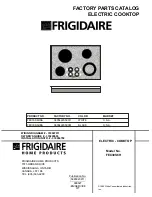
SURFACE COOKING
4
CONTROL KNOBS
Your cooktop is equipped with control knobs that provide an
infinite choice of settings from LOW to HIGH. The knob can
be set on or between any of the numbered settings.
To operate
push down and turn the knob in either direction
to the desired setting. An indicator light will glow when a
surface element is turned on. The indicator light will remain
on until the element is turned off. After a cooking operation,
be sure the element and indicator light are off.
GENERAL COOKING TIPS
To prevent damage to the cooktop or utensil, never operate
surface unit without a pan in place, never allow a pan to boil
dry and never operate an element on HIGH for extended
periods of time.
Food will not cook any faster at a higher setting than needed
to maintain a gentle boil. Water boils at the same
temperature whether boiling gently or vigorously. If a high
setting is used, excessive spattering will occur and food may
stick or burn onto the bottom of the pan.
If a higher heat setting is used to bring liquid to a boil or to
begin cooking, always
reduce
to a lower setting once liquid
comes to a boil or food begins cooking.
Never leave food
unattended during a cooking operation.
Fit the size of the cookware to the size of the element. This
conserves energy.
CANNING
Use HIGH just until water comes to a boil or pressure is
reached in the pressure canner. Then,
reduce
to the lowest
heat setting that maintains the boil or pressure. Prolonged
use of HIGH or the use of incorrect canning utensils will
produce excessive heat. Excessive heat can cause
permanent damage to the porcelain cooktop, coil element
and the drip bowl. See page 5 for additional information.
COOKWARE
Cooking performance is greatly affected by the type of
cookware used. Proper cookware will reduce cooking times,
use less energy and produce more even cooking results. For
best results use a heavy gauge metal pan with a smooth flat
bottom and a tight fitting lid.
Cookware with uneven, warped, or grooved bottoms do not
make good contact with the heating surface, will reduce heat
conductivity and result in slower, less even heating.
Different types of cookware materials require different heat
settings for the same cooking operation. The chart below is
based on heavy gauge aluminum cookware. Lower the heat
setting if using a thinner gauge metal or other materials.
Oversized cookware and cookware that rests across two
elements are not recommended as they may trap enough
heat to cause damage to the cooktop or elements. This is
especially important when canning.
Do not use woks equipped with round metal rings. The ring,
which is designed to support the wok above the element, will
trap heat and may damage the element and the cooktop.
SUGGESTED HEAT SETTING GUIDE
HEAT SETTINGS
To continue cooking covered foods and to maintain pressure in most pressure cookers. Stew, braise
or steam operations. To maintain boil for small amounts of liquid, poach, steam or
simmer.
To brown or sear meat; heat oil for deep fat frying; scald; to saute or fry. Maintain fast boil for large
amounts of liquids.
USES
To bring liquid to a boil, blanch, preheat skillet, or reach pressure in a pressure cooker.
Always
reduce to a lower heat setting when liquids just begin to boil or foods begin to cook.
To maintain moderate to slow boil for large amounts of liquids.
To continue cooking uncovered foods and for most frying operations.
To keep foods warm before serving. Melt chocolate.
HIGH
Medium-High
7-9
Medium
4-6
Medium-Low
1-3
LOW
Refer to cookware manufacturer’s recommendations for suggested heat settings. Some manufacturers do not recommend
the use of HIGH, or the use of HIGH for extended cooking operations.






























